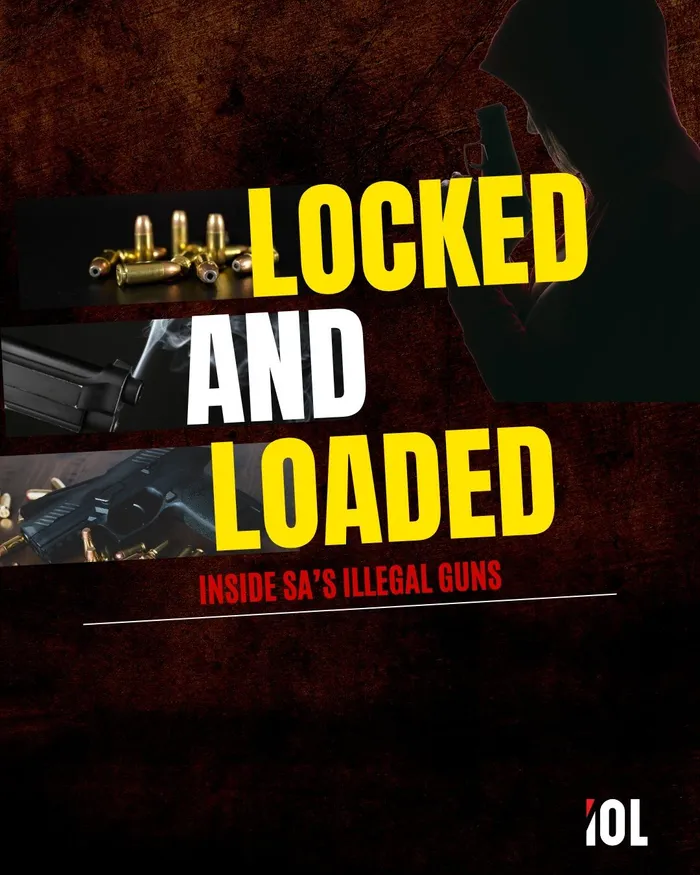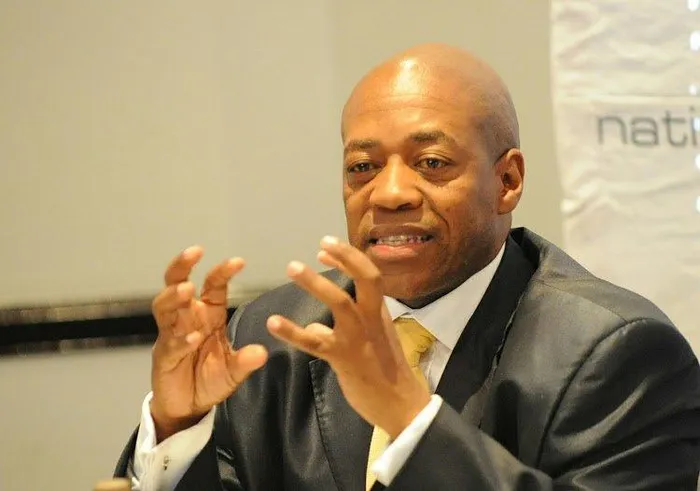Locked and Loaded: How state guns fuel South Africa’s deadly crime wave

Once meant to protect the public, thousands of police and military firearms have slipped from South Africa’s armouries into the hands of criminals — turning the state into an unwitting supplier of the country’s gun violence.
Image: IOL Graphics
When former police colonel Chris Lodewyk Prinsloo walked free on parole after just four years of an 18-year sentence for flooding the Cape Flats with weapons, the underground gun trade cheered.
Back in 2016, Prinsloo was convicted on more than 20 counts of racketeering, corruption and money-laundering for dealing roughly R9 million in lethal firearms to gangsters — many of those guns were meant to be destroyed.
Prinsloo, once head of SAPS’s Gauteng Firearms, Liquor and Second-Hand Goods Unit, ran a covert operation between 2007 and 2015 in which thousands of confiscated or decommissioned police firearms — including pistols and rifles — were siphoned from State stores and sold to Cape Flats gang leaders.
The weapons, some originally seized from criminals, were logged as “destroyed” on official registers but instead delivered through corrupt intermediaries to gangs such as the Americans and the Hard Livings in the Western Cape. Forensic analysis later linked these “Prinsloo guns” to more than 1,000 murders, including children caught in crossfire. His case exposed how deeply South Africa’s armouries had been compromised — and how the State’s own guns became tools of its citizens’ destruction.
Across South Africa, thousands of state-issued guns have taken the same path: from barracks and police stations into the hands of criminals. The State has become one of the country’s biggest suppliers of illegal weapons — a deadly irony at the heart of South Africa’s violent crime crisis.
A Nation Armed — and Bleeding
South African State entities — including the police, defence force, correctional services, and metro police — collectively hold around 2.2 million firearms. Every year, roughly 1,800 state-owned guns are lost or stolen. Many later resurface at murder scenes.
In the 2023/24 financial year, the South African Police Service (SAPS) reported 741 firearms lost or stolen, exceeding its own internal target. But that number only tells part of the story. The South African National Defence Force (SANDF) and other state bodies often fail to publish reliable figures, and when they do, data is fragmented and incomplete.
Without a centralised system, there is no clear national picture of how many state firearms have slipped through the cracks. What is clear is that each missing weapon carries deadly potential.
While the SANDF requested additional time to review and respond to questions posed by IOL, the SAPS had neither acknowledged nor replied to the detailed query at the time of publication. The Private Security Industry Regulatory Authority (PSIRA) confirmed receipt of IOL’s questions last week, but no formal response had been received by Tuesday evening.
Systemic Failure — ‘A Criminogenic Environment’
The leakage of State firearms is not the work of a few rogue officers, says Professor Kholofelo Rakubu, Head of the Department of Law, Safety and Security Management at Tshwane University of Technology. It is the product of systemic decay.
“This isn’t a case of a few bad apples,” she said. “All the conditions for leakage are structurally present — motivated insiders, poorly guarded armouries, and no capable oversight.”
Rakubu draws on Routine Activity Theory to explain the pattern: crime occurs when a motivated offender, a suitable target, and the absence of capable guardianship converge. “In SAPS and SANDF, all three elements are disturbingly present,” she said.
Armouries lack biometric access and surveillance; inventory logs are still kept on paper.
“Manual records can be falsified. Losses go unreported due to fear, inertia, or corruption,” she said. “These institutions have become criminogenic environments — settings that facilitate crime rather than deter it.”
According to Rakubu, a culture of impunity within law enforcement allows negligence and corruption to thrive.
“Firearms can vanish from State custody with little trace and even less consequence,” she said. “When officers lose weapons and face no disciplinary action, it sends a message that misconduct is tolerable.”
In 2022/23, SAPS recovered only about 5% of the more than 8,000 firearms lost or stolen that year. For Rakubu, the low recovery rate reflects a collapse in internal controls.
“Losses are often only discovered when a gun turns up at a crime scene,” she said.
‘The State Is Feeding the Black Market’ — Gun Free South Africa
Dr Stanley Maphosa, Executive Director of Gun Free South Africa (GFSA), describes the leakage of state-owned firearms as “an extremely serious problem.”
He said large discrepancies in official inventory figures indicate that the government cannot confidently account for all weapons issued to SAPS, SANDF and other state agencies.
“That creates ideal conditions for diversion,” he said.
The notorious “Prinsloo guns” scandal remains the clearest example.
“Those guns alone have been linked to more than a thousand murders,” Maphosa said.
“When the state loses control of its own firearms, it directly fuels the illegal market, destabilises communities, and undermines national safety.”
However, Maphosa noted that the state is not the only culprit. Civilians and private security companies also contribute to the problem.
“In 2023/24, civilians reported 8,452 guns lost or stolen — around 23 per day — compared to 741 by police,” he said.
“The state is part of the problem, but the private pool is an even bigger feeder into the criminal market.”
Inside the armouries — ISS on state and private leakage
Willem Els, Senior Training Coordinator at the Institute for Security Studies (ISS), told IOL that South Africa’s illegal firearm trade is sustained in large part by the very institutions tasked with combating it.
“One of the main providers of illegal firearms in South Africa to the criminal networks is actually the South African Police Service and the military,” he said.
“We see that a lot of these firearms that are being recovered are stolen from there.”
He noted that South Africa’s private security sector is also a major risk area.
“We have a private security grouping that is more or less twice as big as the SAPS and the military. Most of them work with firearms in high-risk operations like cash-in-transit. During those heists, two to three rifles are often stolen by criminal gangs.”
Els said that while South Africa has introduced new firearm legislation since 1994, aimed at reducing illegal gun flow, poor management and lack of data have undermined its impact.
“We know what the problem is — the Central Firearms Registry is not what it’s supposed to be. There are a lot of loopholes, and the management is simply not what it should be.”
He also questioned whether gun control measures are evidence-based: “Since 1994 we’ve made it harder to own guns, but how many of these firearms used in crimes actually come from legal owners? How many are stolen from security forces? We don’t have the data.”
Els warned against assuming that all illegal firearms originate from private owners: “It’s wrong to assume that illegal firearms come from law-abiding gun owners, and then tighten legislation around them, when the real problem lies within the security forces and weak institutional management.”
Digital Deficit — Tech, Chips and Real-time Tracking
Andy Mashaile, retired Interpol ambassador and security strategist, warned that the absence of a digital firearms management system at SAPS, SANDF and municipal police bodies leaves a gaping loophole for the corrupt.
“When you have a digital firearms registry, any firearm that gets dispatched to a police officer when they book for duty would automatically update itself on the system,” he said.
“You do not have to do it manually because it will have a chip. That chip would then speak to the computer in the room where you store your firearms, the arsenal.”
Mashaile argued that such a system would drastically reduce opportunities for manipulation and misappropriation. He added that the chain-of-custody for weapons destined for destruction must be foolproof.
“For firearms to be transported from Pretoria or Johannesburg to a smelter in Vanderbijlpark, you need something foolproof from the very members inside the organisation,” he said.
On accountability, Mashaile called for harsher sentences for those responsible for negligent or corrupt loss of state firearms and an overhaul of the Firearms Act and destruction policies to close loopholes that criminals currently exploit. He also urged enhanced regional policing cooperation to stem cross-border flows of illegal weapons.

Former Interpol ambassador Andy Mashaile says technology can help arrest the widespread loss of state firearms.
Image: X
A Nation in Crossfire
South Africa is now at crisis-level gun harm, with 33 people shot dead every day, up from 18 per day in 2009.
“We cannot reduce gun violence while the taps of both state and civilian firearms remain open,” Maphosa said.
Rakubu added that leaked state weapons amplify the lethality of crime.
“When military-grade weapons are used in robberies or gang conflicts, the firepower escalates and communities suffer the consequences,” she said.
“It’s a social catastrophe — people begin to doubt whether the institutions meant to protect them are complicit in their suffering.”
The Way Forward — Reform or Rhetoric?
All four experts agree that South Africa’s institutions can be reformed, but only through political will and cultural change.
Rakubu calls for a complete overhaul of police and military ethics training, stronger supervision, and independent oversight.
“Technology alone won’t fix this,” she warned.
“Without ethical leadership and independent oversight, digital systems will just be new tools in the same old hands.”
Maphosa’s recommendations focus on transparency and accountability:
A forensic audit of all state firearms and civilian licences issued since 2010.
Digitised, corruption-proof chain-of-custody for SAPS and SANDF armouries.
Routine destruction of all recovered firearms after forensic processing.
Quarterly public reporting of all losses, recoveries, and destructions.
Real integrity protections for the new firearm management IT system.
Els agrees that reform must focus on competence and accountability within the state itself.
“We’ve known for decades what the problem is,” he said.
“Until we fix the Central Firearms Registry and strengthen internal management, we’ll keep seeing state and private weapons end up on the streets.”
Mashaile added that technical fixes such as chipped weapons and real-time registries must be paired with legal reform and regional cooperation: “You need harsher sentences, tighter destruction protocols and cross-border policing to close the loopholes that allow stolen state weapons to travel.”
Accountability at Gunpoint
The guns meant to protect South Africans are killing them instead. Behind every leaked weapon lies a paper trail of negligence, corruption, and silence. As experts warn, this is not just a law enforcement failure — it is a crisis of governance and public trust.
Until the state can account for every gun it owns, South Africa will remain a nation armed against itself.
jonisayi.maromo@iol.co.za
IOL News